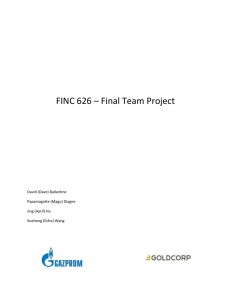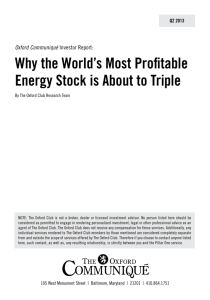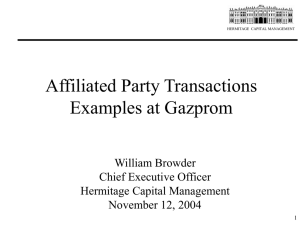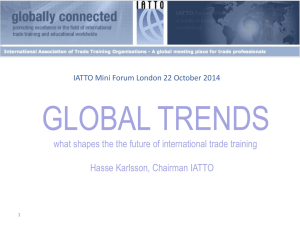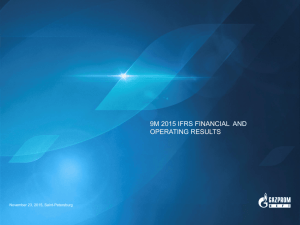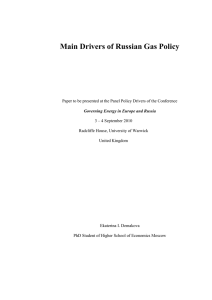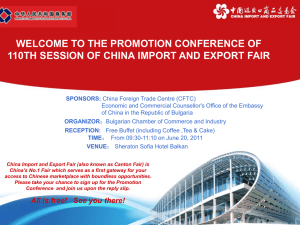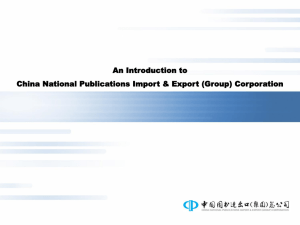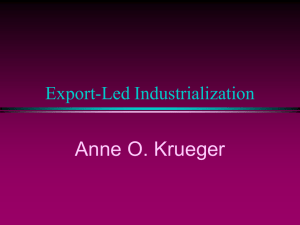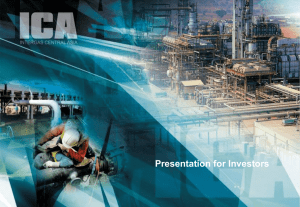a_belyi
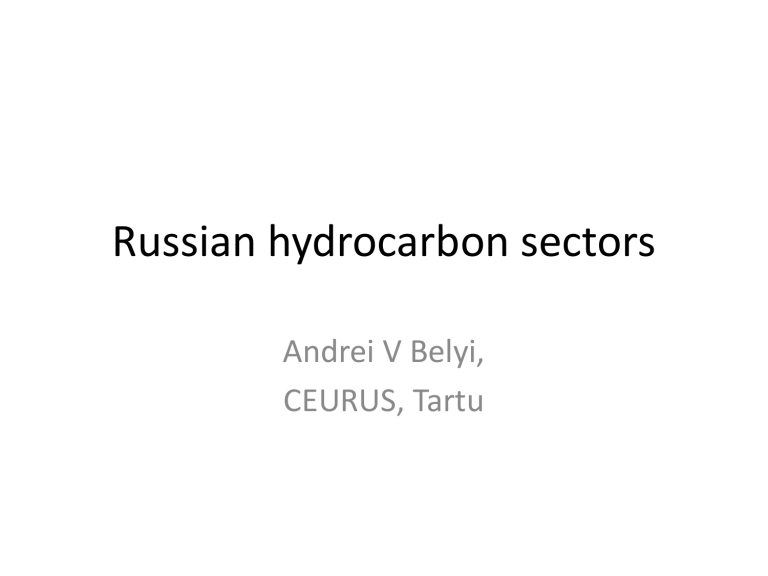
Russian hydrocarbon sectors
Andrei V Belyi,
CEURUS, Tartu
structure
1. Historical and institutional specificities
2. Reserves, production and exports
3. Dynamics in oil sector
4. Oil pipelines
5. Gas sector: domestic issues
6. Gas Export dimension State-owned companies
7. Gazprom and Rosneft: new policy dimensions
1. Historical and institutional specificities
Soviet legacies of energy sectors
Non-rentable wide scale infrastructure (oil and gas pipelines, electricity networks)
Geology based resource classification (no link to market)
Social importance of access to resources, energy price and access to export
Increased rate of over-investments (corruption?)
High energy intensity (TPES/GDP), about 0.5
In addition, Russia’s political strategy remains in scope of disputes
Decrease the role of the
State in the economic segments or reinforce the
State especially in the oil sector?
Dvorkovich view to support privatization
Sechin view to reinforce
State in energy
Regulation of hydrocarbon
• No energy-specific regulator
– Federal Anti-Monopoly Service (FAS) covering issues of competition, anti-trust and consumer protection (remains very liberal)
– Federal Tariff Service (FTS) covering price regulation in natural monopolies; also responsible for monitoring of price
– Ministries: (1) Economic development, (2) Energy and (3) Natural
Resources
• Oil sector was restructured since 1992
– No monopoly on export but a growing concentration on production
– Oil pipelines are unbundled from production, private pipelines are possible
• Gas sector exempted from restructuring
– But legislation is set for a wholesale market, issues with implementation
– Gazprom owns MRG, the pipeline operator
– Export monopoly, de-jure since 2005
2. Reserves, production and exports
Before 1917
Vast reserves allowed an energy intensive economy but access to new fields in Eastern
Regions is more difficult hence requires a new approach
First drilling in Baku in 1846 (second drilling after US in
1814)
Volga region develomment since
1864
Source: IEA, 2002 , TEK, 2008 and BBVA, 2008
1917-1955 Large and exploration production works started in
North Caucasus,
Volga-Ural regions
1955-1991
Baku
N. Caspian
Timan Pichora
Volga
Urals
1991- to date
Exploration ongoing
Negative prospects for further oil discoveries proven to be wrong: with
Timan Pichora and
Western Siberia oil reserves Russian production boosted
New discoveries provide even larger production potential in the short-term production increase:
North Caspian, East
Siberia Sakhalin,
Russian and
Siberian North still has an important estimated resource potential
Access to upstream
Licensing
• Allocated by Ministry of natural resources
• Licenses for exploration separated from licenses for production
• Ministry may revoke the license. Disputes resolved by Highest
Arbitral Tribunal
PSA
• Separate legal regime approved by State
Duma
• No link with State taxation policies
• In case of Sakhalin energy: State exerted pressure by using
“environmental monitoring”
Russia’s oil and gas production since 2000
Russia is the first world gas producer,
But gas consumption close to the EU level
Oil Export growth with the production, but half of oil goes for Russian internal market
700,00
600,00
500,00
400,00
300,00
200,00
BCM
100,00
0,00
Production
Domestic consumption
600
500
400
300
200
100
Up to 70% of gas production is consumed
Domestically
0
323
144
348
164
380
190
421
Production
459
260
230
Export
470
262
Mln tons
481
Mln tons
258
2000 2001 2002 2003 2004 2005 2006 2007
Russia is the world largest oil and gas producer
But also a large hydrocarbon consumer
How to accommodate domestic demand and export ambitions?
Exports historically oriented to Europe
(outdated map shows that by 2001 no exports to Asia)
3. Dynamics in oil sector
Russian oil companies
Approx. Production share in brakets
1992-2000
VSNK
(3-5%)
Yukos
(12-13%)
2001-2003
Yukos acquires
VSNK
(20-21%)
2003-2010
Rosneft
(28%) state-owned
Rosneft
(5-6%)
Onako
(1-2%)
Sidanko
(8-9%)
TNK
(9-10%)
Sibneft
(7-8%)
Gazprom
(7-8%)
Tatneft
(7-8%)
SurgutNG
(11-12%)
Lukoil
(19%)
Rosneft
(5-6%)
TNK acquires
Sidanko,
Onako
(12%)
Slavneft
(4%)
Sibneft
(9-10%)
Gazprom
(7%)
Tatneft
(5-6%)
SurgutNG
(15%)
TNK-British
Petroleum
Holding
(16-17%) private
Gazpromneft
(8%)
State-owned
Tatneft
(6%) regionally owned
SurgutNG
(16-17%) private
Lukoil
(22%) private
Lukoil
(19%)
Slavneft
(5-7%)
Reasons for concentration:
– Political :
Concentration of the control over strategic state resources
Easier conditions to conclude profitable concessions
– Economic/financial:
Larger profits stimulated by the high world oil prices
Attraction of external capital to invest into the sector
– Technical:
Better capability to exploit difficult areas of resources
With purchase of TNK-BP (2012), Rosneft can be defined as a new NOC
• Transition from command to market
economy in the 1990s lead to a decrease in production. In 1998 oil production represented 59% of its 1990 level
• After 1999: oil sector regained its strength with the economic stabilization and world price increase
• In 2004 Largest production subsidiary
Yuganskenftegaz was taken over by the state owned company Rosneft from Yukos
• Stagnation after 2007 mainly due to inefficient taxation system (Royalty is linked to world oil price)
• Tax relief since 2009 for greenfields but limited effect
• In 2013 production rate reached the level of 1988 but average marginal costs are high
• Regulation on access to small fields is stalled
Oil Production and export: historical trends
Mln tons 1992: private and state-owned oil companies start operating Russian oil sector
600
Mln tons
500
400
300
200
Oil production decline after Break-down of the USSR (1991) Due to under-Investments
1995-99: lowest production level
100
0
1988 1990 1991 1992 1995 1998 1999 2003 2005 2007
Source: Oil & Capital
Profits decline unwillingness to change classification to avoid decrease in capitalization
Oil products
Vertically integrated structure of oil refining and downstream distribution remains (i.e. low level of inter-company exchanges)
Quasi-monopolistic structure in downstream pushes prices up, Marginal costs are also above western average
Federal Antimonopoly Service (FAS) attempts to pressure oil company on prices
Increase of environmental standards (i.e. introduction of Euro standard for gasoil) have been inefficient (companies tend to decrease refining capacities, prices go up, but revenues decline)
Refineries are concentrated on the western part of Russia
Levels of price vary from 0.6 Eur to 1 Eur per l.
Yakutia and Far East have the highest levels (low market fragmentation)
Source: Russian Energy Agency, 2013
Transneft pipelines
Specificities:
– Telescope down effect: built to supply former satellite countries, the pipeline capacity is small on export points due to the low demand in Eastern Europe.
– Different heavy and light oil sorts are commingled in Druzhba pipeline within one flow (so called Urals), Ministry of Energy constantly delayed quality banking
– Pro rata regulation is applied: all oil producers get a quota according to the production level
World longest oil pipeline network
Source: TEK, 2008
Baltic terminals
Black sea terminals ( crude oil oil products
Constructed during
Soviet era, pipeline sector needs to be reshaped in order to meet world market structure
Length: 50 000 km
Average shipment length: 3000 km
Druzhba pipeline: 5500km
Página 14
Geography of export by pipeline: decrease of Druzhba and increase of terminals
Geography of Transneft oil shipments in time
Source: TEK, 2008
100%
80%
60%
40%
20%
0%
Before
1992
2001-2005 2005-2008 2010 2012
Druzhba To Black Sea To Baltic Sea To Pacific
Oil shipment via Druzhba and
Black sea terminals decreases
Proportionally to an increased use of Baltic terminals and of the Pacific in future.
Effects: decrease of shipment to Baltic branches (LV and LT)
Other pipelines
Baltic Pipeline System (since 2002): new pipelines owned by Transeft
AS: Transneft allocates quotas to
Kz
• CPC - Private consortium lead by Shevron (US)
• Commercial agreements for access, laws on natural monopolies do not apply
5. Russian gas sector: domestic issues
EU oriented export, East direction is underdeveloped
Russia is the first world gas producer
700,00
600,00
500,00
400,00
BCM
300,00
200,00
100,00
0,00
Production
Domestic consumption
Russia is the world leading gas consumer:
Up to 70% of gas production is consumed
Domestically need to reduce gas flaring
Export is monopolized by Gazprom
Oil companies and independents sell gas domestically
Novatek aims at producing
115-120 bcm by 2020
Gazprom would allocate an internal market, but price is uncompetitive
Pressure on exports Oct 2012 Novatek concludes 10 yrs agreement to supply German costumer EnBV with 2 bcm annually
1992-2010
Institutional setting
Increased role of FAS in limiting incumbent (Gazprom)
Gazprom gets however priority access in the upstream, mainly Arctics
Hence, level of fragmentation remains marginal HHI is about 7000
Gazprom now controls up to 17% of generation with 36 GW of installed capacity
Long term effect on electricity market: if gas price is increased, and market fragmentation remains low, consumers will be sensitive to the price of fuel (gas)
Towards wholesale market?
2007: first electronic trading platform
• Trade from 5+5 to 7+7 bcm, but slows down since
2009
2010: Decree on wholesale market
• Aiming at increasing sector’s efficiency
2013 amendment: FTS not to regulate the price but the access to pipelines only
• objective to have a wholesale market by 2015
• No real implementation
MRG (pipeline operator) is responsible in drafting access code
The issue of pricing is crucial since
2012!
• Market to control Gazprom’s price hikes?
• Or to find an alternative in the context of stagnating exports?
6. Export dimension
Gazprom’s gas deliveries to Europe 2007-2011
Export in bcm
Other (incl. Hub trade) in bcm
Price in USD per MMBTU
2007
153
16
7.6
2008
160
8
11.6
Source: T. Vehrs, Gazprom Germania presentation, Tallinn 14.11.2012
2009
148
7
7.3
2010
139
10
8.5
2011
150
9
10.8
Most of gas is delivered under long term contracts, long term upstream investments needed:
- Development of upstream: Northern Yamal, South East Nadym Pur Taz; Far
East; Eastern Siberia
- Largest investment plans: 40 billion USD till 2020 (mostly transport infrastructure) need for long term contracts with take-or-pay
Gazprom participates in the spot, and increases competition for the European retailers ground for disputes
EU-Russia gas trade issues
European retailers are under pressure on TPA; anti-trust monitoring against GDF and Eon
Gazprom attempts to keep price indexation to oil, in spite of the opposite trend (up to 50% of gas is hub-based in Europe)
PGNIG, EON: agreements on adjustments of long term contracts; RWE
Transgas won an arbitral case against Gazprom on take-or-pay
Impact on relations with Ukraine? (Ukraine demands to decrease volumes without take-or-pay payment)
However: LNG export liberalization is foreseen for Autumn 2013
Gazprom and Baltic States: area of difficulty
Estonia Latvia Lithuania
Eesti Gaas
Ltd.
JSC
Latvijas
Gaze
JSC
Lietuvos
Dujos
Gazprom -
37%
Itera Latvia-
9.85%
Gazprom -
25%
Itera Latvia-
25%
Gazprom -
37.1%
Most difficulties are with Baltic states, where Gazprom has stakes in distribution
EE and LT decided to implement full ownership unbundling disputes
7. State-owned companies:
Gazprom and Rosneft
• Both Rosneft and Gazprom are state-owned but dynamic of influence is different
– Gazprom is a VIC which is in path to a decentralization (without losing the institutional structure)
– Rosneft became a China-type NOC
• Financial differences:
– Since 2000s oil export revenue is higher (reaching 172 bln USD in
2012) then of gas (58 bln USD for gas)
– Rosneft is less dependent on exports
– Rosneft was successful in dealing with China
– Level of securitization of oil imports from Russia is much less significant
